3D bioprinting is no longer the futuristic technology often associated with science fiction. Although we are still very far from producing full-scale functional organs, there are a few practical applications to this technology other than academic research.
The actual definition of a bioprinter is still evolving. For the sake of simplicity, we will consider a bioprinter to be a machine capable of printing with living cells and biomaterials based on digital models. This definition encompasses a considerable number of already available machines, so for this article, we will only highlight established machines that are currently being used for research or other similar purposes.
In the following sections, we’ll talk about not only the hardware but also the journeys of the companies and the developers behind them.
General-Purpose Bioprinters
Bioprinting technology is also being used for purposes other than academic research. While there aren’t any organ factories yet, bioprinting was proven suitable for more practical applications in preclinical drug testing and innovative regenerative medicine therapies.
All 3D bioprinters in this category can be purchased without any kind of partnership or research program.
Cellink BIO X6
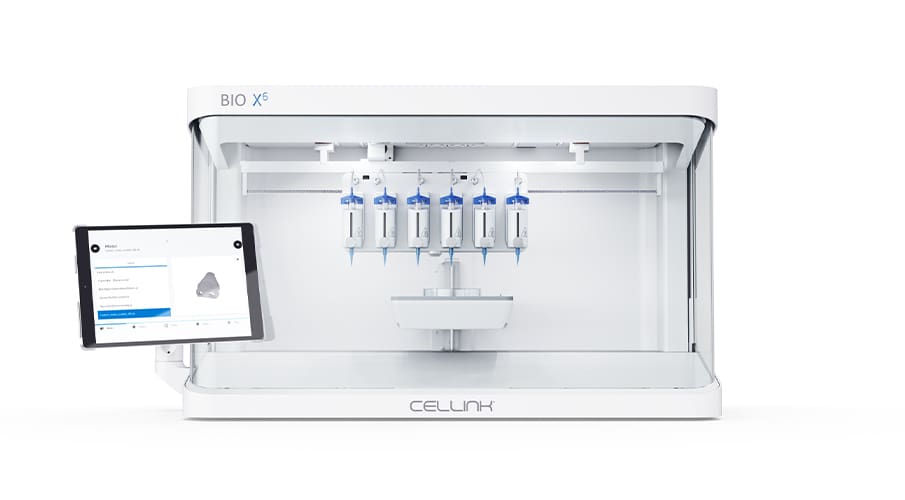
The Bio X6 is one of the most advanced machines from Cellink, a company based in Boston. Despite being established in 2016, it’s one of the largest manufacturers of bioprinters, designing and developing bioprinting technologies for the most diverse applications.
The company has a large portfolio in biofabrication hardware: six machines in total, including its latest release, the BIO MDX series. Cellink has also ventured into biomaterials, having developed a universal bioink. Currently, they offer more than 50 ready-to-use varieties.
The Bio X6 has six printheads featuring the so-called “Clean Chamber Technology”, a high-powered air pressure system that drives extrusion through the syringes. According to the company, it’s a high-throughput machine suitable for a range of different applications.
The Bio X6 comes with various innovative features, like an HD camera for process control, a pneumatic printhead for high-viscosity materials, and even an incredible electromagnetic droplet printhead, which allows for a fast drop-on-demand build, similar to ink-jet techniques.
- Developed and sold by: Cellink
- Model: Bio X6
- Type: Extrusion-based
- Country: United States
Allevi Series
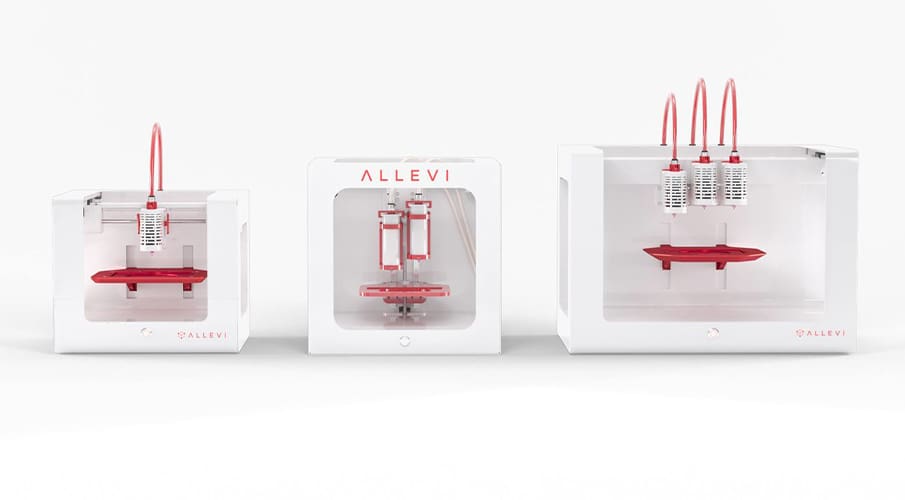
Allevi, formerly the start-up BioBots, is an American company established in 2014. At first, their main goal was to make biofabrication easier because, at that time, all 3D bioprinters were either very expensive, difficult to use, or both.
In just one year, the company went on to develop the BioBots 1, a low-cost desktop 3D bioprinter. The company, now part of 3D Systems, currently has three 3D bioprinter models in its portfolio: the Allevi 1, the Allevi 2, and the Allevi 3.
Their names indicate the number of extruders on each machine, but the differences between these models go further than printheads, with the Allevi 3 being much more precise (1 μm) than its siblings (7.5 μm for the Allevi 1 and 5 μm for the Allevi 2).
These bioprinters use LED photocuring with multiple light waves to solidify the material without harming the living cells. This allows the Allevi machines to work with different biomaterials, such as collagen, alginate, methacrylate, polyethylene glycol, and of course, various hydrogels.
- Developed and sold by: Allevi
- Model: Allevi 1, 2, 3
- Type: Extrusion-based
- Country: United States
BioAssemblyBot 400
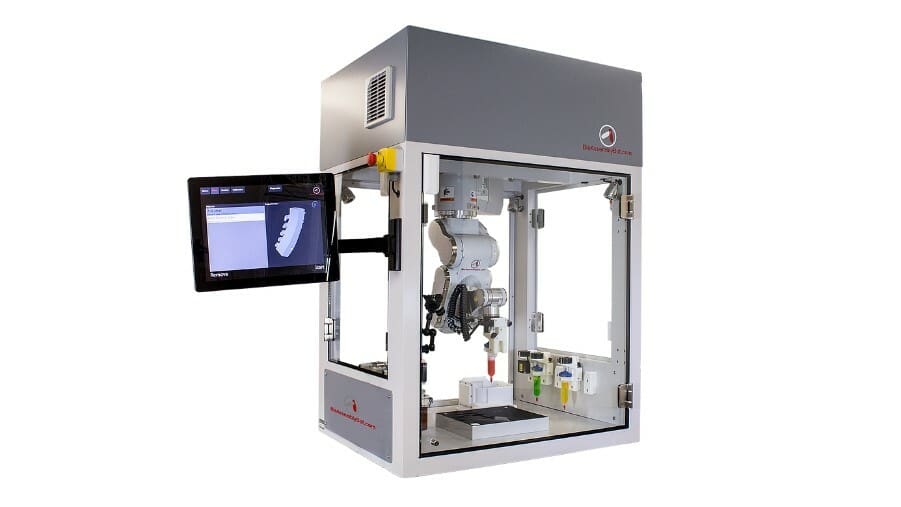
Advanced Solutions Life Sciences is an American company that, since 2010, has been dedicated to designing and developing hardware and software solutions in the field of biofabrication. Its first bioprinter, the BioAssemblyBot, was released in 2016 and later awarded a patent in 2018.
Now, the American company offers both high-end and low-cost bioprinters. For instance, the BioBot Basic model is a polar desktop bioprinter that is currently priced at around $5,500.
At the other end of the spectrum, the BioAssemblyBot 400 is the high-tech model said to leverage over 60 years of industrial robotic innovation. It’s one of the few bioprinters capable of multi-axis printing, which is achieved by its six-axis robotic arm. In addition, the machine can be fitted with a range of printheads and other devices, including cameras with machine learning and AI tools for automated calibration and failure correction.
The BioAssemblyBot 400 is marketed as a highly productive machine. According to the company, the BioAssemblyBot platform is currently used by its customers for drug discovery, personalized medicine, and regenerative therapeutics, among other applications.
- Developed and sold by: Advanced Solutions Life Sciences
- Model: BioAssemblyBot 400
- Type: Extrusion-based
- Country: United States
Bioplatforms
With “bioplatforms”, we refer to systems that offer additional functionalities that go beyond construction, including features like cell incubation, monitoring, integrated software, built-in microscopes, and more.
Naturally, these multi-purpose systems are on the high-end side of bioprinting, both in terms of functionality and cost.
RegenHu R-Gen 200
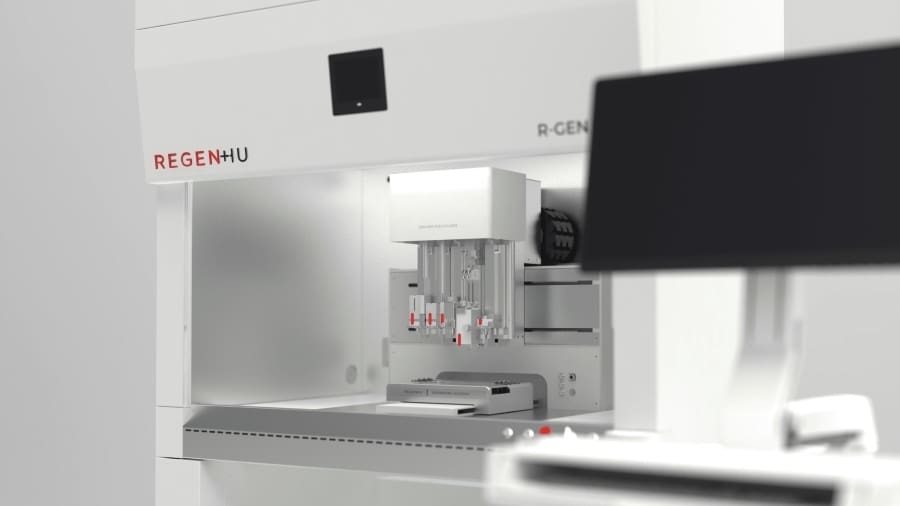
RegenHu, which stands for “Regeneration Human”, was founded in 2007. Since its beginning, it has gone for a unique strategy: investing in worldwide collaborations and partnerships. The company now holds several exclusive patents in biofabrication, which have been developed over many years through academic and international partners.
The first bioprinting system developed and commercialized by the Swiss company was the 3DDiscovery Evolution, which can be considered the co-author of over 200 scientific publications worldwide.
RegenHu has recently upgraded its product portfolio, bringing two new bioprinters models: the R-Gen 100, a tabletop machine, and the massive R-Gen 200, a so-called “bioprinting station”.
With its modular printhead system, the R-Gen 200 supports up to six different dispensing technologies and various materials. Each head has independent temperature control, and calibration is entirely automated. The system also offers a built-in biosafety enclosure and proprietary planning software for 2D and 3D design as well as process control.
All of RegenHu’s 3D bioprinter models are available for purchase.
- Developed and sold by: RegenHu
- Model: R-Gen 200
- Type: Extrusion-based
- Country: Switzerland
Rokit Dr. Invivo 4D6
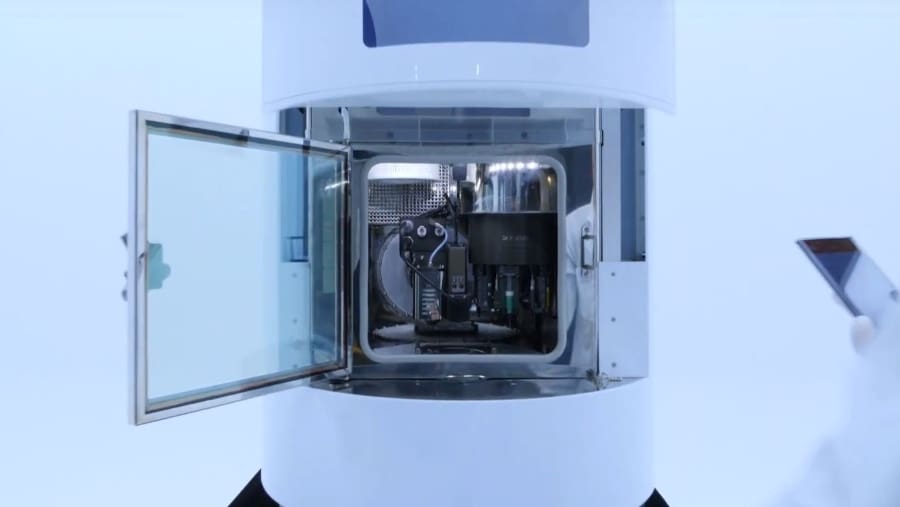
In 2015, Korean 3D printer manufacturer Rokit announced that it would start working on in-situ bioprinting for skin regeneration. With a considerable $3 million funding from the Korean government, the company released its first bioprinter in just one year: the Invivo.
Later in 2019, Rokit demonstrated a new bioprinting method to treat scarred lesions. The Invivo was able to print the patient’s own cells and tissues into a dermal patch graft, which would be placed over lesions, allowing for the natural regeneration of the skin.
Rokit went on to become “Rokit Healthcare” and is now much more focused on regenerative medicine than tissue engineering. Today, the Dr. Invivo 4D6 is Rokit’s most advanced system, as it combines many unique features in comparison to other bioplatforms.
Besides its modular printhead system with automatic calibration and bed leveling, the 4D6 boasts a built-in cell incubator with CO2 level control, UV chamber sterilization system, optical microscope, multi-platform printing bed – the list go on.
- Developed and sold by: Rokit Healthcare
- Model: Dr. Invivo 4D6
- Type: Extrusion-based
- Country: South Korea
Fluicell Biopixlar Platform

Fluicell is a Swedish company specializing in high-resolution bioprinting. Founded in 2012 by three researchers from the Chalmers University of Technology in Gothenburg, the company has been publicly traded since 2018.
Fluicell is known for its unique bioprinting technology, a microfluidic flow technique capable of printing at an astonishing single-cell resolution. This means that biological materials can be printed one cell at a time.
The Biopixlar platform is an all-in-one solution for tissue engineering and regenerative medicine research. Due to its printing technology, this bioprinter is ideal for handling rare and valuable materials like stem cells or material collected from biopsies.
The Biopixlar also boasts advanced features, like a built-in microscope and a multicolor fluorescence imaging system for real-time monitoring of the printing process. Last but not least, this system comes with an ambient-controlled chamber and a gamepad interface for advanced control of the printhead.
- Developed and sold by: Fluicell
- Model: Biopixlar
- Type: Proprietary microfluidic technology
- Country: Sweden
Research-Focused Bioprinters
While 3D bioprinting mostly remains in research, the machines in this category come from a stronger research background and offer features that enhance experimentation and scientific development.
Note that some of these bioprinters are only available through research partnerships with the manufacturers.
EnvisionTec 3D-Bioplotter
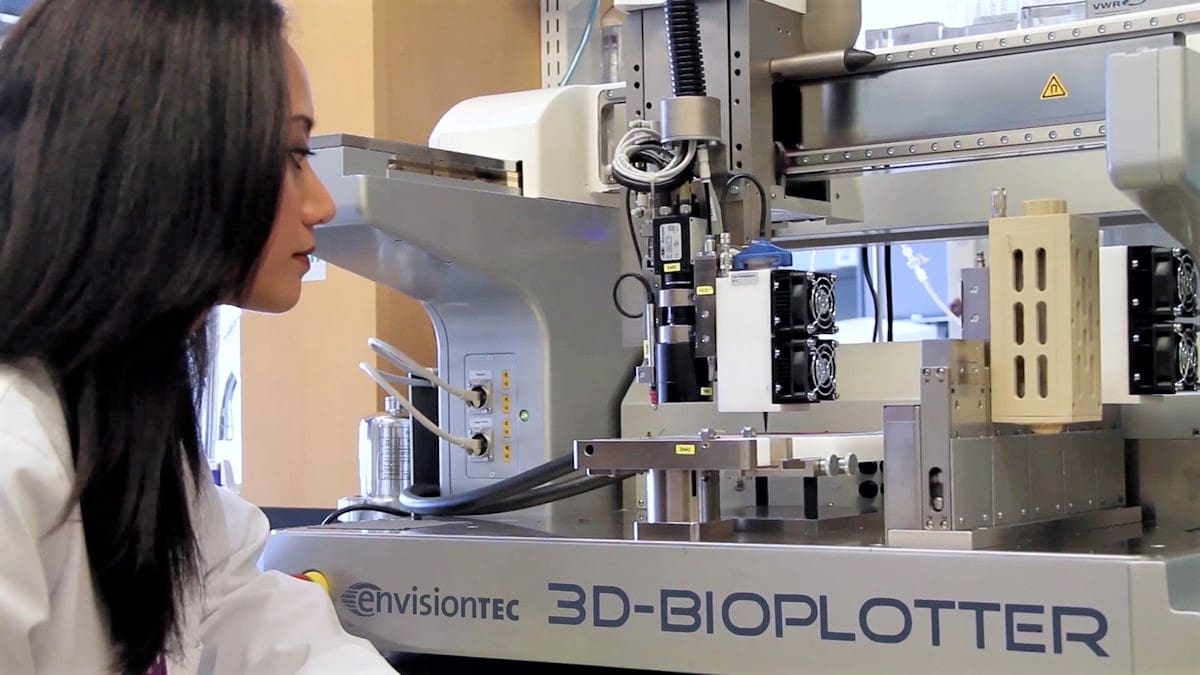
The 3D-Bioplotter from EnvisionTec is one of the first commercially available 3D bioprinters. Developed by Professor Ralf Mulhapt’s group at the University of Freiburg, Germany, it was one of only a few academic projects that have successfully gone to market. More recently, EnvisionTec was acquired by Desktop Metal.
EnvisionTec first launched it in 2000, making the Bioplotter one of the most seasoned bioprinters of its kind. At the time of writing, over 450 scientific papers have been written with the aid of these printers.
The Bioplotter is available in three different versions that differ based on the type of application. According to the company, the Starter and the Developer Series are best for research groups new to the field of tissue engineering, whereas the Manufacturer Series is a more robust and feature-rich system for more heavy-duty applications.
The Bioplotter is an extrusion-based bioprinter, capable of holding up to five printheads and a maximum axis resolution of an astonishing 0.001 mm. This bioprinter is also capable of making scaffold structures from a wide range of materials, from thermoplastics to medical-grade silicone.
All versions of the Bioplotter are available for purchase. Costs vary depending on the model and the optional features, with some setups costing well over $200,000.
- Developed and sold by: EnvisionTec
- Model: 3D-Bioplotter
- Type: Extrusion-based
- Country: Germany
Inventia Rastrum
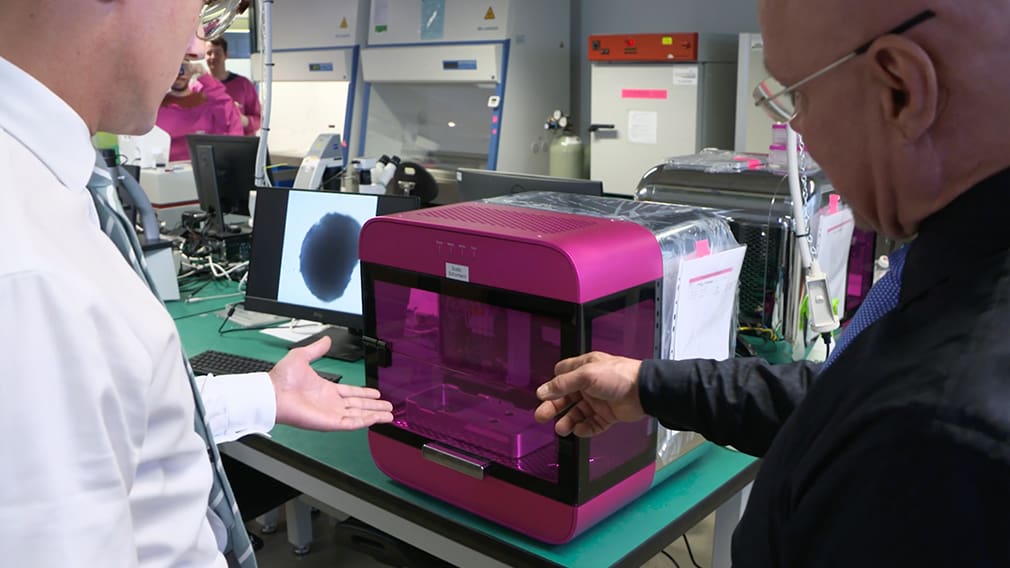
With its distinctive color, the Rastrum 3D bioprinter truly draws attention to itself. The machine was developed by Inventia Life Science Operations, an Australian company founded in 2013 for developing and manufacturing bio-fabrication equipment. The company focuses on advanced medical research, especially cancer treatment.
The Rastrum is an ink-jet bioprinter, capable of producing 3D cell models at a very high speed. The impressive throughput of the machine allows for hundreds of experiments to be performed in a single day.
Sleek and compact, the Rastrum is ideal for desktop use in laboratories. In fact, it won the Australian “Good Design Award of the Year” in 2019.
Inventia claims the Rastrum can print up to 10 different cells and matrix components simultaneously, and that it can be applied to organ and tissue engineering. This 3D bioprinter is only available to research groups and companies through a partnership program with Inventia.
- Developed and sold by: Inventia Life Science Operations
- Model: Rastrum
- Type: Ink-jet
- Country: Australia
Aspect Biosystems RX1
Canadian Aspect Biosystems is a medical research company that came up with a unique platform for 3D bioprinting, which they trademarked as “Lab-on-a-Printer”. This technology was patented and can be described as a mix between microfluidics and 3D printing.
Rather than a regular syringe with bioink, this method uses specialized printheads that can control the mixture of up to four different biomaterials, in a variety of patterns. This streamlines the entire process by eliminating the need to change material, with the added benefit of cross-linking the mixed materials with high precision.
The RX1 bioprinter makes use of this technology, as it was designed to be compatible with a wide range of biomaterials. The microfluidics allows unprecedented flexibility for seamless biomaterial patterning and, in turn, the fabrication of complex tissues resembling their physiological counterparts.
Aspect Biosystems works based on partnership programs and does not market its bioprinter.
- Developed and sold by: Aspect Biosystems
- Model: RX1
- Type: Extrusion-based
- Country: Canada
Bioprinting Solutions Fabion 2

3D Bioprinting Solutions is a research laboratory founded in 2013 by a private medical company in Russia. Within a year of its creation, the company unveiled the first Russian 3D bioprinter: the Fabion.
The company has always made it clear that its main goal is to fabricate functional organs. As a matter of fact, Bioprinting Solutions successfully printed a mouse thyroid gland in 2015.
Not satisfied with that, in 2018, the company went on to print the same organ, but at the International Space Station with its Organaut bioprinter.
The Fabion 2, however, which was released in 2016, is the true second-generation model. It brings new functionality by printing complex structures using single-tissue spheroids. It can also handle a wide range of biomaterials and uses different types of polymerization.
Bioprinting Solutions does not sell its products, but it is open for collaboration in biofabrication research.
- Developed and sold by: 3D Bioprinting Solutions
- Model: Fabion 2
- Type: Extrusion-based
- Country: Russia
Poietis NGB-R
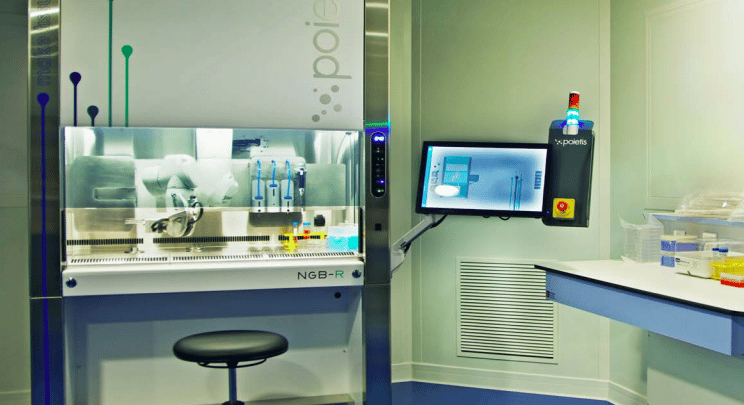
NGB stands for “Next-Generation Bioprinting”, and it’s an accurate name. The NGB-R bioprinter developed by Poietis uses relatively new technology for printing. Specifically, it combines laser-assisted, micro-valve and extrusion bioprinting in order to achieve extremely high resolution and control.
It is a complex printing process that uses 10,000 laser pulses per second to deposit microscopic droplets of bioink onto the build surface. This technique was conceptualized in 2006, eight years before the French start-up Poietis was founded. You can see how they work in the video below.
Poietis specializes in developing and manufacturing in-vitro human tissues, and their 3D bioprinting has been extremely successful. In 2015, the company partnered with the global chemical giant BASF for the development of 3D printed skin for cosmetic testing purposes. Today, it’s responsible for the first commercial bioprinted human tissue, the Poieskin.
According to the company, the NGB-R model is designed specifically for tissue engineers, researchers, and biologists and is available for purchase with Poietis directly. Research partnerships are also possible, especially with pharmaceutical and cosmetic industrial groups.
- Developed and sold by: Poietis
- Model: NGB-R
- Types: Laser-assisted, micro-valve, extrusion
- Country: France
Organovo NovoGen MMX
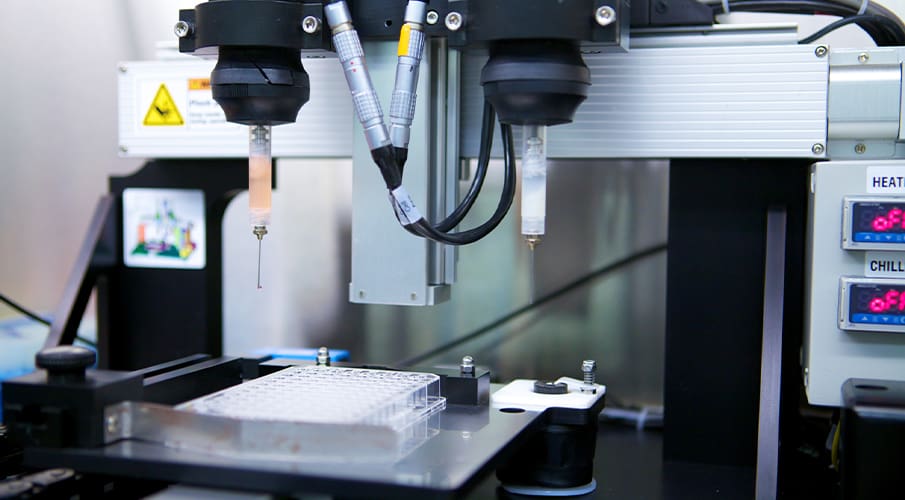
Organovo is likely one of the most well-known biofabrication companies in the world.
Its NovoGen MMX was announced by the American company back in 2009, and it was developed in collaboration with Invetech. It’s an extrusion-based printer, which includes two printheads to simultaneously build with live cells and their support material.
Organovo went public in 2012, and it’s still one of the few companies to do so. They’re focused on producing lab-grown tissues for accelerating pre-clinical drug testing and medical research. According to the company, it’s been used to create a wide variety of tissues, including from the liver, kidney, intestine, skin, eye, and breast.
Organovo doesn’t market the NovoGen bioprinter. Instead, the American company produces tissues in-house and sells them to partners mainly for research purposes.
- Developed and sold by: Organovo
- Model: NovoGen MMX
- Type: Extrusion-based
- Country: US
Lead image source: CELLINK via YouTube
License: The text of "Top Commercial 3D Bioprinters" by All3DP Pro is licensed under a Creative Commons Attribution 4.0 International License.